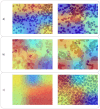A deep learning-based model for detecting Leishmania amastigotes in microscopic slides: a new approach to telemedicine
- PMID: 38824500
- PMCID: PMC11144338
- DOI: 10.1186/s12879-024-09428-4
A deep learning-based model for detecting Leishmania amastigotes in microscopic slides: a new approach to telemedicine
Abstract
Background: Leishmaniasis, an illness caused by protozoa, accounts for a substantial number of human fatalities globally, thereby emerging as one of the most fatal parasitic diseases. The conventional methods employed for detecting the Leishmania parasite through microscopy are not only time-consuming but also susceptible to errors. Therefore, the main objective of this study is to develop a model based on deep learning, a subfield of artificial intelligence, that could facilitate automated diagnosis of leishmaniasis.
Methods: In this research, we introduce LeishFuNet, a deep learning framework designed for detecting Leishmania parasites in microscopic images. To enhance the performance of our model through same-domain transfer learning, we initially train four distinct models: VGG19, ResNet50, MobileNetV2, and DenseNet 169 on a dataset related to another infectious disease, COVID-19. These trained models are then utilized as new pre-trained models and fine-tuned on a set of 292 self-collected high-resolution microscopic images, consisting of 138 positive cases and 154 negative cases. The final prediction is generated through the fusion of information analyzed by these pre-trained models. Grad-CAM, an explainable artificial intelligence technique, is implemented to demonstrate the model's interpretability.
Results: The final results of utilizing our model for detecting amastigotes in microscopic images are as follows: accuracy of 98.95 1.4%, specificity of 98 2.67%, sensitivity of 100%, precision of 97.91 2.77%, F1-score of 98.92 1.43%, and Area Under Receiver Operating Characteristic Curve of 99 1.33.
Conclusion: The newly devised system is precise, swift, user-friendly, and economical, thus indicating the potential of deep learning as a substitute for the prevailing leishmanial diagnostic techniques.
Keywords: Artificial intelligence; Deep learning; Image processing; Leishmania; Machine learning; Microscopic images; Transfer learning.
© 2024. The Author(s).
Conflict of interest statement
The author(s) declared no potential conflicts of interest with respect to the research, authorship, and/or publication of this article.
Figures







Similar articles
-
A machine learning-based system for detecting leishmaniasis in microscopic images.BMC Infect Dis. 2022 Jan 12;22(1):48. doi: 10.1186/s12879-022-07029-7. BMC Infect Dis. 2022. PMID: 35022031 Free PMC article.
-
DeepLeish: a deep learning based support system for the detection of Leishmaniasis parasite from Giemsa-stained microscope images.BMC Med Imaging. 2024 Jun 18;24(1):152. doi: 10.1186/s12880-024-01333-1. BMC Med Imaging. 2024. PMID: 38890604 Free PMC article.
-
A new diagnostic method and tool for cutaneous leishmaniasis based on artificial intelligence techniques.Comput Biol Med. 2025 Jun;192(Pt B):110313. doi: 10.1016/j.compbiomed.2025.110313. Epub 2025 May 12. Comput Biol Med. 2025. PMID: 40359677
-
Scoping Review of Deep Learning Techniques for Diagnosis, Drug Discovery, and Vaccine Development in Leishmaniasis.Transbound Emerg Dis. 2024 Jan 17;2024:6621199. doi: 10.1155/2024/6621199. eCollection 2024. Transbound Emerg Dis. 2024. PMID: 40303156 Free PMC article.
-
Automated Monkeypox Skin Lesion Detection Using Deep Learning and Transfer Learning Techniques.Int J Environ Res Public Health. 2023 Mar 1;20(5):4422. doi: 10.3390/ijerph20054422. Int J Environ Res Public Health. 2023. PMID: 36901430 Free PMC article. Review.
Cited by
-
Enhanced Detection of Leishmania Parasites in Microscopic Images Using Machine Learning Models.Sensors (Basel). 2024 Dec 21;24(24):8180. doi: 10.3390/s24248180. Sensors (Basel). 2024. PMID: 39771915 Free PMC article.
-
Human-Validated Neural Networks for Precise Amastigote Categorization and Quantification to Accelerate Drug Discovery in Leishmaniasis.ACS Omega. 2024 Dec 24;10(1):1177-1187. doi: 10.1021/acsomega.4c08735. eCollection 2025 Jan 14. ACS Omega. 2024. PMID: 39829493 Free PMC article.
References
-
- Souto EB, Dias-Ferreira J, Craveiro SA, Severino P, Sanchez-Lopez E, Garcia ML, Silva AM, Souto SB, Mahant S. Therapeutic interventions for countering leishmaniasis and chagas’s disease: from traditional sources to nanotechnological systems. Pathogens. 2019;8(3):119. doi: 10.3390/pathogens8030119. - DOI - PMC - PubMed
-
- Lin Y, Fang K, Zheng Y, Wang H-l, Wu J. Global burden and trends of neglected tropical diseases from 1990 to 2019. J Travel Med 2022, 29(3). - PubMed
MeSH terms
LinkOut - more resources
Full Text Sources
Medical

